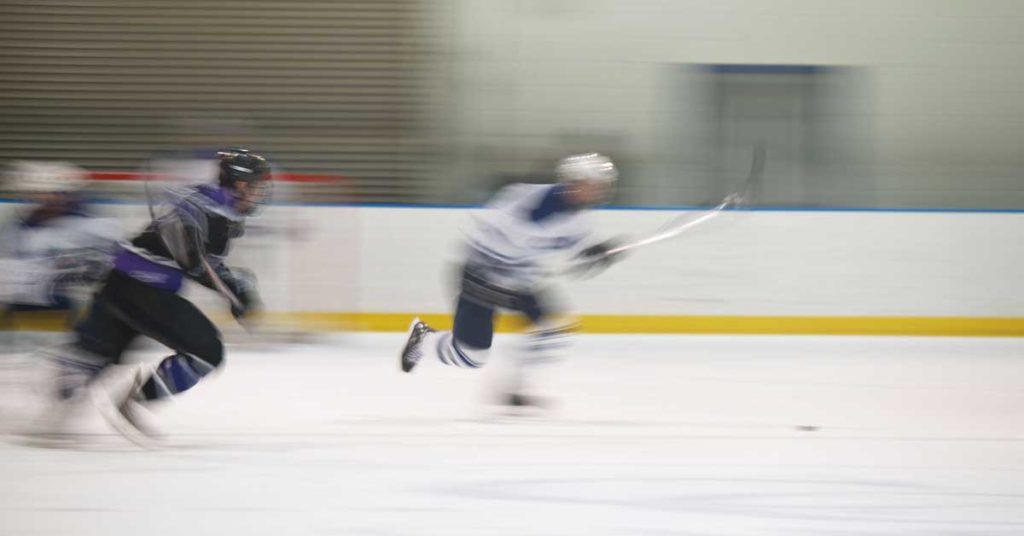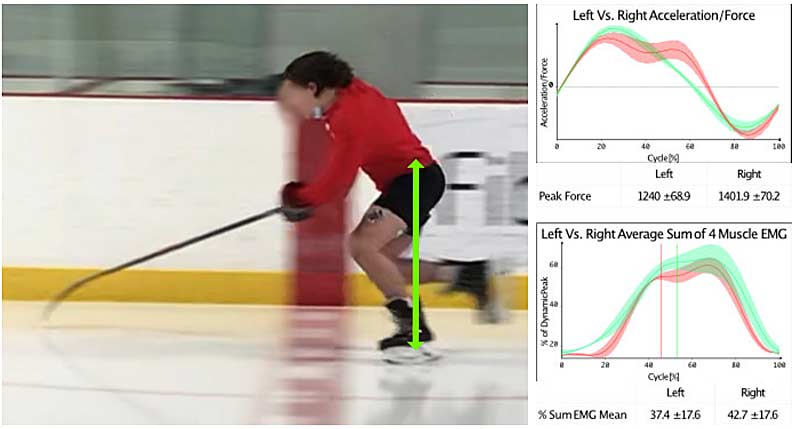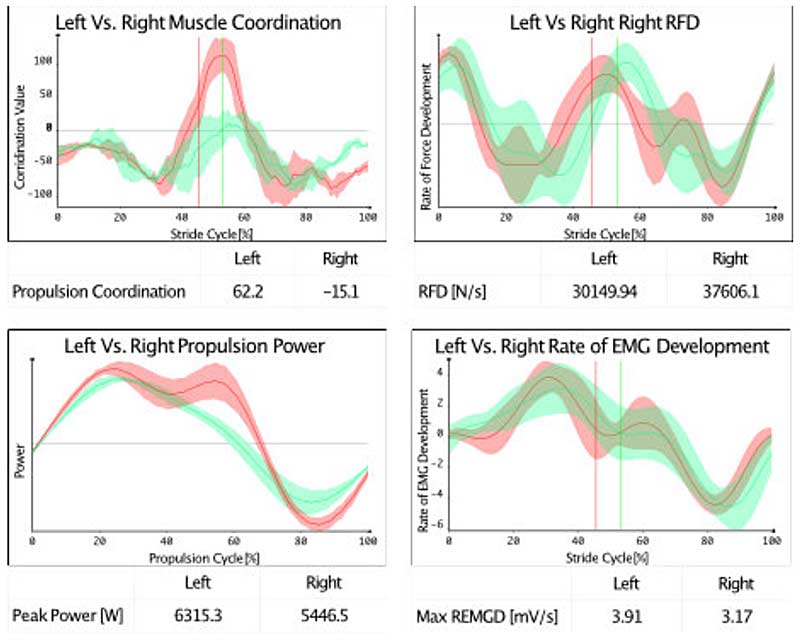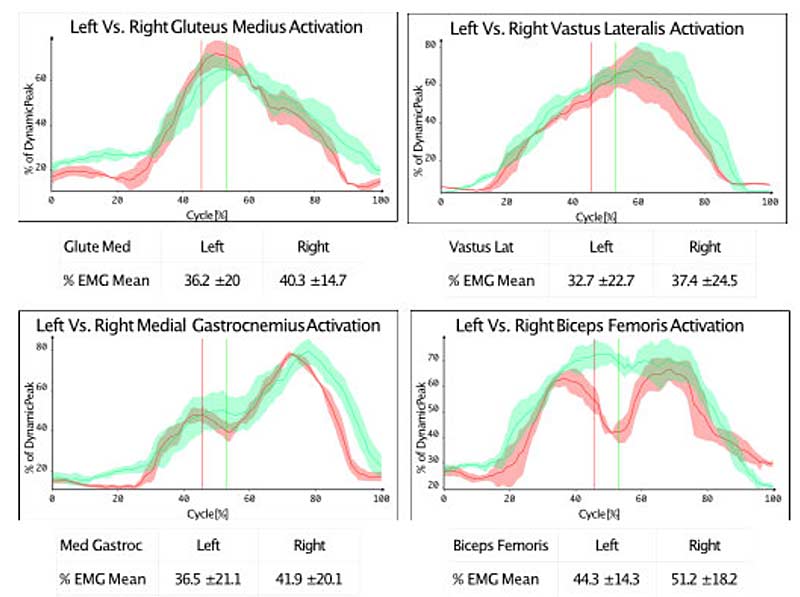
Hockey is one of the fastest games in the world. Players rely on quick bursts of speed combined with highly developed motor skills to outmaneuver competitors and gain possession of the puck. The player who gets to the puck or into position first got there by converting high amounts of muscular force into acceleration. Although we know that stronger players are often faster players, using that strength efficiently by coordinating and activating their muscles efficiently can make the difference between teams scoring goals and teams trailing behind.
A multitude of field tests exist to assess power, force production, acceleration, speed, and rate of force production. These tests evaluate the sum of the muscle actions on the body to propel it through space and can be a valuable way to determine both if a training regimen is getting results and how an individual player compares to other players on the team. What is more difficult to tell from these tests, however, is how the athlete’s muscles are activating and coordinating to cause this movement—and if they are doing it efficiently to maximize their performance.
EMG analysis can show what field tests can’t—how the athlete’s muscles are activating and coordinating and if they are doing it efficiently to maximize the athlete’s performance. Share on XFor this purpose, EMG analysis can prove to be invaluable in helping pinpoint areas that need attention to increase the whole of the performance.
Assessment Methods
In this article, I assess an elite hockey player in a blue line to blue line all-out sprint (15.24 meters, to be exact). Doing this allows insight into how his muscles activate and coordinate during the test’s acceleration portion. We used a single inertial monitor (G-Sensor from BTS Bioengineering) attached at the S1 level to approximate the center of mass to measure his acceleration.
To gather muscle activation information, we used eight wireless EMG sensors (FREEEMG from BTS Bioengineering) secured to the gluteus medius (GMed), vastus lateralis (VL), medial gastrocnemius (gastroc), and biceps femoris (BF) on both the left and right sides. Since the G-Sensor measures acceleration in three dimensions (x, y, and z axes), it is necessary to take these three components and calculate the final 3D acceleration vector. We can get 3D acceleration, velocity, and distance from this initial calculation using the combined vertical, horizontal, and lateral movements. Because this calculation represents all up, down, and side-to-side movements, the final values can differ from pure linear measurements.

To reliably compare left and right sides, it was necessary to identify key movement indicators along with muscle activation cycles. Skating has two distinct movement phases:
- The initial strides are more like running, with higher ground reaction forces during the maximal accelerative component.
- The later strides incorporate a more prolonged glide phase, and these last strides result in lower ground reaction forces once the skater gets up to speed.
To help me determine the key points and kinematics of the skating stride, I consulted with Gabe Glasser, a biomechanical engineer who now works with Biomechanics Research and Testing. Gabe was invaluable in sharing his knowledge and insights in creating the final protocol.
To compare how muscle activation contributes to the performance during critical points in the skating stride, I used EMG readings combined with acceleration values. Share on XTo compare how muscle activation contributes to the performance during critical points in the skating stride, I decided to use the EMG readings combined with the acceleration values. As the propulsion phase begins, the foot is below the center of gravity and about halfway through the stride, where acceleration is just starting to turn positive. This time point also coincides with the muscle activation of the sum of the four muscles as it approaches peak activation. For the purpose of an accurate left and right comparison when looking at acceleration, I chose the first six full strides of the performance to examine, as muscle coordination and activation changes as the player approaches peak speed and moves more to a gliding phase. I did not include the initial push-off phase as this may have confounded the results in comparing the left and right sides.

Looking at the charts, it may be intuitive that EMG activity would parallel movement, but remember it takes time for the electrical activity in the muscle to convert to force to cause motion. This effect is called electromechanical delay and can influence the interaction by approximately 50-100 milliseconds depending on the muscle that is being measured. To keep it simple, I have not considered this a significant trainable effect (although research has both supported and disputed this) that can contribute to acceleration in this case. Since electromechanical delay can influence interpretation, it is essential to remember that EMG activation that results in movement could happen up to 100 milliseconds before the actual movement occurs.
Assessment Results
After three maximal on-ice sprint trials, the left side showed a higher rate of EMG development and peak power (power was calculated as force x velocity every 1/100th of a second during the propulsion phase). In comparison, the right side showed a higher rate of force development (RFD was calculated by taking the derivative of the force curves), acceleration, and overall muscle activation during the sprints. Muscle coordination was more synchronous at the start of the propulsion stage on the right side (as shown by the line approaching the zero mark) than the left, suggesting a more asynchronous activation.

Measuring median frequency (MDF) can also give us some insight into the motor units’ activity. Although somewhat controversial, MDF is more likely representative of the conduction velocity of the motor units. In general, larger and faster motor units tend to recruit at higher frequencies and conduction velocities and are also, on average, closer to the surface of the leg muscles. Many factors can affect MDF, such as fatigue, motor unit cross-sectional area, and depth of motor units from the electrodes. Although electrode placement can also affect MDF, the difference is not as sensitive or as large as amplitude measurements.
In this case, fatigue did not appear to be a factor, as the length of each sprint was close to three seconds and MDF frequency appeared relatively stable throughout the trials. The differences between the left and right GMed and BF frequencies were similar; however, the right VL and gastroc were higher by approximately 20%. This may suggest that the right VL and gastroc had greater overall motor unit conduction velocities that may have contributed to slightly higher acceleration and force generation on that side.
You would think a higher rate of EMG development (how quickly the muscle can activate to a certain level) would also result in a higher rate of force development (how quickly the body can develop a given force). Also, since the right side produced greater peak force at the beginning of the propulsion stage, you might surmise that it would also have greater power. Since power is force x velocity, you get higher powers by moving faster with higher forces. However, remember that the speed when the propulsive force is applied is also related to the last stride, so in this case, it might be difficult to tell if one side was more powerful than the other. We do know that the right side had a higher peak acceleration than the left, so it appears the right side transferred its force-generating capabilities better than the left.

Although the left side has a higher EMG development rate and higher peak power, the right side has a higher RFD, peak force, and acceleration, and better inter-and intramuscular coordination. Intramuscular coordination is how individual muscles recruit motor units and vary firing rates to produce more force. We know better intramuscular coordination occurs alongside a higher mean EMG activation and often with higher MDF frequencies. Inter-muscular coordination is how multiple muscles work together to cause movement. In the end, both types of coordination are essential.
Although there are a few ways to assess muscle coordination, I chose the more straightforward mathematical way by using a dispersion index as described in the article by Rejc et al. (2010). This approach looks at the sum of the differences between all the muscles together. As the graphed line approaches zero, the EMG activations levels are more similar since the difference between them becomes smaller. Farther away from zero indicates less similarity and less synchronous activity.
As you can see from the graph, the right side has good synchronous muscle coordination at the onset of the propulsion phase. In contrast, the left is becoming less synchronous, meaning the inter-muscle coordination is diverging, and the muscles are not contracting in a similar pattern as the right.
In a fluid movement, you want just the right amount of antagonist activity for joint stabilization, but not so much that it is resisting the action of the agonists. Share on XIn an ideal situation, you would want individual muscles firing precisely at the right time, along with high synchronous motor unit recruitment rates. Optimally activated individual muscles that contract at the wrong time result in lower performances, just as synchronous recruitment of multiple muscles with poor intramuscular coordination will not result in the best possible performance.
Even though we only looked at four muscles to get a snapshot of the whole picture, it is also good to know how antagonist muscle activity contributes. In a fluid movement, you want just the right amount of antagonist activity for joint stabilization, but not so much that it is resisting the action of the agonists. In our hockey player case, we focused primarily on agonist and synergist muscles while monitoring the activity of the BF. The BF is a double-jointed muscle that plays multiple roles in the skating stride. It can act as a knee stabilizer during eccentric knee extension, an antagonist and stabilizer during concentric knee extension, and a synergist during hip extension.

The other unique and exciting aspect of EMG analysis is sometimes you find things you didn’t set out to measure. Although the sum of the average activation of the four muscles is relatively close, when you break down the four muscle activations, there is a potential red flag. Typically, BF activation acts as a stabilizer while the knee extends and the quadriceps activate. This action helps protect the knee from an adverse movement that can stress the knee ligaments, such as the ACL.
The other unique and exciting aspect of EMG analysis is sometimes you find things you didn’t set out to measure. Share on XIn looking at the activation patterns of the four individual muscles of the left leg near the start of the propulsion stage, there is a noticeable drop inactivation of approximately 20% compared to the right side, where activation stays relatively consistent. Although you could argue that you would want deactivation of the BF during knee extension, this would also place the left knee at greater risk of injury due to the change in co-activation with the quadriceps, especially at high speeds. This type of activity is an additional individual factor that should be examined and possibly addressed during his off-ice training to help prevent future knee injury.
Training Recommendations
With the idea that we want good inter-muscular coordination with all the essential muscles firing simultaneously during the propulsion phase on both sides, we can address this issue by modifying the athlete’s training routine. Most research has found that muscle coordination patterns are generally individualized, especially in high-level elite athletes. The reasons for this can range from genetic factors such as bone, muscle, and tendon length to trainable factors such as early established neurologic movement patterns, the elasticity of tissues, and the force and rate of force capabilities of individual muscles.
There is a plethora of information on improving strength, power, muscle development, and speed through various training techniques. However, the research on improving unilateral muscle coordination through training is far from extensive and its importance is often mentioned more as an aside, unlike addressing it directly as is done for intramuscular coordination. With that said, some techniques DO NOT appear to help inter-muscle coordination and synchrony:
- Bilateral movements (as athletes can unknowingly favor or weight one side over the other).
- Fast, unweighted movements.
- Lower-intensity resistance training.
Now that we know what probably won’t help this particular athlete, let’s examine what will.
Maximal Strength Training
To improve inter-muscular coordination, maximal resistance in the range of one to three reps per set has shown promising results. This type of high-intensity training should also include a comprehensive risk analysis that considers the athlete’s training history, fitness level, and time during the season.
To improve inter-muscular coordination, maximal resistance in the range of 1-3 reps per set has shown promising results. Share on XThe general rule of thumb is if the athlete can squat 1.5 to 2 times their body weight, we would focus on lower volume and higher intensity weights applied as unilateral exercises. Exercises such as a modified step-up or a single-leg squat might be good alternatives. If overall lower body strength were not as high, the focus would shift toward increasing overall strength. Current research suggests that improving strength, up to the previously mentioned level, affects acceleration more than applying specific techniques.
Resisted Ballistic Training Combined with Moving as Quickly as Possible
Notice I have used the word “resisted” (or added weight), as unweighted ballistic training has less of an effect on improving inter-muscular coordination. However, this can include plyometrics, which can also have a moderate impact on improving inter-muscular coordination. As there are substantial ground reaction forces during the first few strides, this is an appropriate method. However, around the sixth stride, there is a switch to a more gliding motion, which drastically reduces these ground reaction forces and renders plyometric training maybe not as relevant for overall speed.
During these exercises, there should be a purposeful intention to move the body as fast as possible regardless of whether there is a high level of speed. Remind the athlete to put their mind into the motion by getting them to focus on explosive movements. Drawing their attention to one side at a time will help train their neurological system to recruit as many muscles as possible at the same time. Exercises might include weighted, single-leg diagonal long jumps, unilateral sled work, or on-ice resisted drills.
Optimal power generation generally occurs at about 30% of maximum weight and should be performed separately from maximal resistance training.
General Notes
Additionally, keep the following in mind.
- Train unfatigued. Fatigue has also been shown to change inter-muscular coordination, so it is best to perform this type of training first in the workout after an adequate warm-up. Different coordination patterns can emerge as other muscles try to take over from fatiguing muscles.
- Improve flexibility at the end of the workout. Elastic properties of the connective tissue can also change muscle coordination patterns, so make sure both sides are equal in range of motion. Take an overall approach to making certain that flexibility is within a normal range by incorporating a mixture of static and dynamic stretches. Not only can this help improve skating technique, but it can also guard against potential injury. Since stretching can decrease activation, it is wise to do this at the end of the workout or separate it from coordination training.
- Specificity. A classic principle applies here as it does to all types of training. Your movements should be as specific to the propulsion phase of the skating stride as possible to improve the necessary muscle activation timing. Generalized “gym training” appears to have very little to no effect on sport-specific muscle coordinative patterns. This statement reinforces the observation that despite the elite athlete gaining strength in the gym, there is often very little transfer to increasing performance. Acceptable approaches are machines and dry land multi-joint exercises that mimic the skating stride or on-ice resisted unilateral ballistic exercises.
Providing More Answers
To summarize, our hockey player has shown that the current left side inter-muscular coordination may not maximize his acceleration during an on-ice sprint. Even though the left side may activate faster and generate higher peak power values, the right side suggests better intra- and inter-muscular coordination, overall higher peak force and acceleration, and a higher rate of overall force development. To improve left side muscle coordination so that the muscles work together to produce a higher rate of acceleration, we would want to incorporate training for unilateral maximal strength combined with ballistic-type movements with added resistance.
Assessing muscle coordination can be a complex issue—muscle coordination patterns can be highly individualized, especially in elite athletes. Training for inter-muscular coordination is best for athletes above 16 who have also developed adequate strength levels. Using EMG analysis combined with inertial sensors can provide more answers to identifying, addressing, and resolving the issue and help to improve overall performance.
Since you’re here…
…we have a small favor to ask. More people are reading SimpliFaster than ever, and each week we bring you compelling content from coaches, sport scientists, and physiotherapists who are devoted to building better athletes. Please take a moment to share the articles on social media, engage the authors with questions and comments below, and link to articles when appropriate if you have a blog or participate on forums of related topics. — SF
References
Rejc, E., Lazzer, S., Antonutto, G., Isola, M., and di Prampero, P.E. “Bilateral deficit and EMG activity during explosive lower limb contractions against different overloads.” European Journal of Applied Physiology. 2010;108:157-165.
Shell, J., Robbins, S., Dixon, P., Renaud P., Turcotte, R., Wu, R., and Pearsall D. “Skating start propulsion: three-dimensional kinematic analysis of elite male and female ice hockey players.” Sports Biomechanics. 2017;16(3):313-324.
Renaud, P.J., Robbins, S., Dixon, P., Shell, J.R., Turcotte, R., and Pearsall, D. “Ice hockey skate starts: a comparison of high and low calibre skaters.” Sports Engineering. 2017;20:255-266.
Burnie, Louise Annabelle.“The effects of strength training on intermuscular coordination during maximal cycling.” Doctoral, Sheffield Hallam University, 2020.

